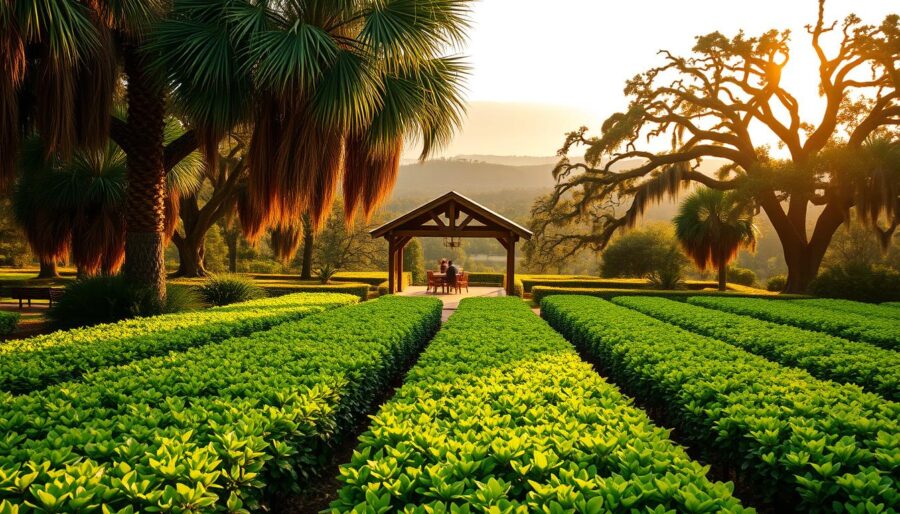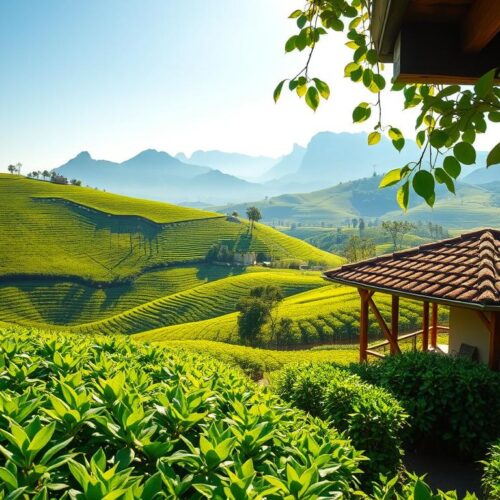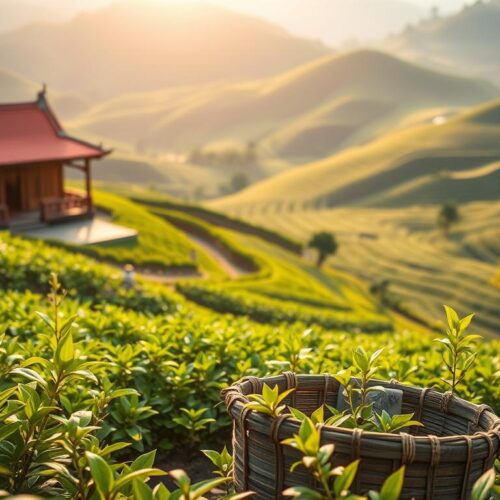You show up at Wadmalaw Island where the scenery is breathtaking. Live oaks frame the coastal breeze. Rows of Camellia sinensis aim towards the marsh. Welcome to the Charleston Tea Garden. It’s the only place in the U.S. where tea is grown on a large scale. On a Charleston Tea Garden tour, history comes to life. You’ll see how iced tea traditions and soft summer light fill the day.
Located just south of Charleston, South Carolina, the garden spreads over 127 acres. You can go on a narrated trolley tour to see it all. They offer a free self-guided tour inside the factory too. Here, you learn how tea leaves become the American Classic tea. You can also check out the Propagation Hut, see how plants start growing, and try hot or cold tea samples. Then, relax in a front-porch rocker before you go.
Every part of the visit to Charleston Tea Garden is special. You get to taste tea that’s grown right there, in the Lowcountry. The soil and the salt air make it unique. Whether you want to have a picnic or just taste different teas, the Charleston Tea Garden is a great place. It makes it easy for families to enjoy Wadmalaw Island and learn about its tea story.
American grown tea in South Carolina: how Wadmalaw Island became tea country
You step onto Wadmalaw Island and feel why tea took root here. The island’s sandy soils drain quickly. Humidity hangs over live oaks with Spanish moss. The sub-tropical climate and roughly 52 inches of rain a year, mirror East Asian tea zones. This inspired early tea plantings in South Carolina.
Wadmalaw Island is about 10 miles long and 6 miles wide. It connects to the mainland by a bridge over Church Creek. It’s one of Charleston’s least changed spots. This quiet area, near historic Rockville, blends farming and sea trade. Now, it helps grow American tea on a large scale.
On a tea farm in South Carolina that tourists can visit, rows of Camellia sinensis plants look like hedges. They are clipped to stay a certain height. Harvest starts in May. Machines collect the green leaf tops. Warm days, regular rain, and coastal winds keep the plants producing all season.
The type of soil and temperature are key. Sandy loam soil helps roots stay healthy. Steady warmth encourages new growth. As a result, tea leaves grow reliably. This lets American tea flourish on Wadmalaw Island, year after year.
Driving past live oaks, you see how the Lowcountry surrounds the fields. The cycle is simple: rain, warmth, and good soil. This mix lets a South Carolina tea farm prosper. Wadmalaw Island is at the center of this unique coastal area.
From Michaux to Bigelow: the historic roots of American Classic tea
The story begins in the late 1700s. French botanist André Michaux planted Camellia sinensis near Middleton Barony in Summerville. He shared starts with Henry Middleton. The idea took off, but they faced many challenges such as labor, the climate, and how to process it.
In 1884, things changed when Dr. Charles Shepard started the Pinehurst Tea Plantation in Summerville. He made green, black, and oolong teas. His tea even won first prize at the 1904 World’s Fair in St. Louis. After Shepard passed away in 1915, his dream began to fade, but his plants lived on.
Years later, in 1960, Thomas J. Lipton saved cuttings from Pinehurst. He moved them to a farm on Wadmalaw Island. Those plants became the foundation for the Charleston Tea Garden.
Then, in 1987, William Barclay Hall and Mack Fleming took over. They started what we know today as the Charleston Tea Plantation. Their efforts led to the creation of American Classic tea.
In 2003, R.C. Bigelow teamed up with Hall. This move secured the future for the Charleston Tea Garden. Bigelow introduced modern tools, ensured consistent supply, and strengthened the brand’s identity. Now, American Classic tea is a symbol of South Carolina, enjoyed across the country.
| Milestone | Year | Location | Why It Matters |
|---|---|---|---|
| André Michaux introduces Camellia sinensis | Late 1700s | Summerville (Middleton Barony) | First documented tea plantings in South Carolina, setting the stage for the Charleston Tea Garden lineage. |
| Dr. Charles Shepard founds Pinehurst Tea Plantation | 1884 | Summerville | Proves U.S. tea can thrive and diversify into oolong and black styles. |
| Pinehurst wins at the World’s Fair | 1904 | St. Louis | National recognition boosts credibility for American Classic tea’s forebears. |
| Lipton moves Pinehurst cuttings to research farm | 1960 | Wadmalaw Island | Preserves elite genetics that later shape the Charleston Tea Garden fields. |
| Hall and Fleming launch Charleston Tea Plantation | 1987 | Wadmalaw Island | Creates the foundation for American Classic tea as a modern, local brand. |
| R.C. Bigelow acquires and expands operations | 2003 | Wadmalaw Island | Combines family stewardship with scale, keeping American Classic tea tied to the Charleston Tea Garden. |
Today’s tea shares a connection with its history, thanks to Bigelow and the historic plants. This crop is a testament to curiosity, science, and tradition in the South.
The rebirth of a tea farm South Carolina can call its own
After early trials ended, Lipton’s 1960 farm on Wadmalaw Island kept Pinehurst-era gear and plants. This saved history started a new story at the Charleston Tea Garden. It launched American grown tea.
In 1987, William Barclay Hall bought the place. He transformed it into a 127-acre farm. Now, as American Classic tea, it’s sold across the country. Hall, with a tea tasting legacy, still leads there.
Bigelow Tea took over in 2003. They kept Hall and brought improvements and open doors for visitors all year. Together, they made a tea farm that South Carolina can explore and enjoy.
The visit is special. You can relax on a big porch, shop for gifts, and try tea at the bar. They offer free looks at the making of tea and a full tour. This shows every step from plant to drink.
The Charleston Tea Garden is open daily, except some holidays. It’s home to historic plants, suited to the local weather. They ensure high-quality American tea.
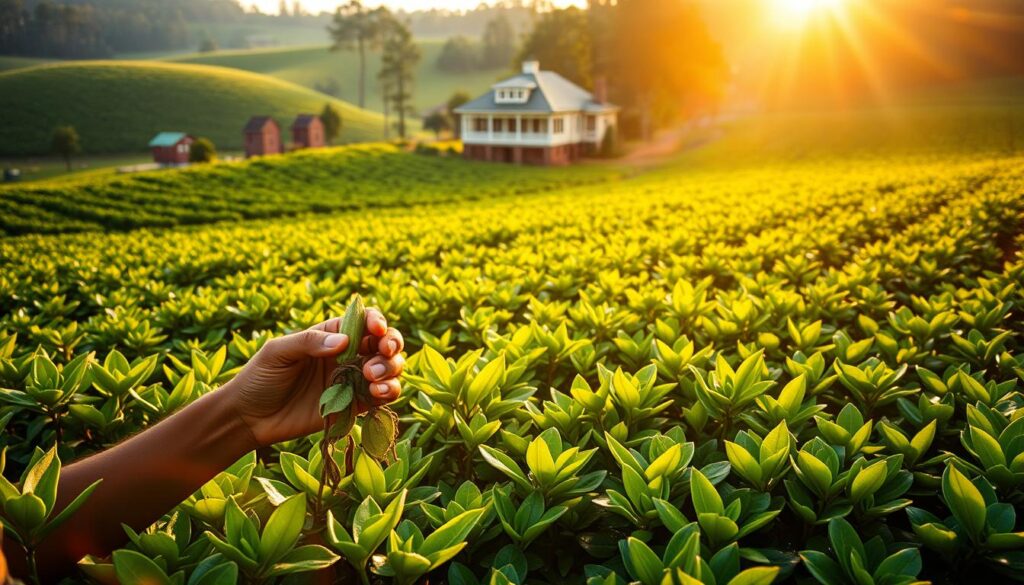
| Milestone | Year | What Changed for You | Impact on American grown tea |
|---|---|---|---|
| Lipton research farm preserves Pinehurst genetics | 1960 | Foundational plants and equipment maintained on Wadmalaw | Continuity of U.S. tea cultivars and field know-how |
| William Barclay Hall converts site to working estate | 1987 | Access to a functional tea farm South Carolina can recognize and support | Launch of American Classic tea for national distribution |
| Bigelow acquisition with Hall’s leadership | 2003 | Improved quality systems, stable supply, and public access | Scaled, consistent Charleston Tea Garden output |
| Visitor amenities expanded | 2000s–present | Porch, gift shop, tasting bar, self-guided factory viewing, trolley tour | Deeper education and demand for American grown tea |
The Charleston Tea Garden grew from research into a popular spot. Here, you go from seeing sturdy plants to tasting fresh tea. It’s a part of South Carolina we’re proud to share nationwide.
Charleston Tea Garden tour
Your Charleston Tea Garden tour starts with a peaceful 40-minute drive from downtown Charleston. You’ll travel beneath live oaks covered in Spanish moss to Wadmalaw Island. The place is calm and coastal, leading to fields of glossy tea hedges at the garden’s entrance.
Once you arrive, head into the visitor center for free tastings of hot and iced teas. Next, explore the self-guided factory tour on your own. Here, displays and working equipment explain the tea-making steps: withering, rolling, and drying. The layout makes it simple to understand and enjoyable to follow.
For an in-depth experience, buy tickets for the trolley tour that covers 127 acres. You’ll be guided by a mix of live and recorded stories from William “Bill” Barclay Hall. He talks about tea growing on Wadmalaw Island and the garden’s adaptation to the Lowcountry’s weather. Each trolley is named after a Derby legend, like Man o’ War.
Visit from May through October, and you might see the harvest happening. You’ll learn about the “Green Giant”, a machine inspired by Lipton, used for trimming the tea hedges. The tour is designed to be family-friendly, with plenty of chances to snap pictures and even picnic on the grounds.
By the tour’s end, you’ll understand how the Charleston Tea Garden combines craft and location. You’ll leave knowing how this garden keeps American tea culture alive on Wadmalaw Island. You see its dedication to growing tea, season after season.
Tea processing up close: from leaf to cup on Wadmalaw Island
The season’s rhythm is clear from May to October, as hedges grow tall. The custom Green Giant trims the shoots, letting a small team manage the process. Then, the freshly cut leaves go to the Charleston Tea Garden for transformation.
First, the leaves are laid on beds where warm air removes moisture gently. They then pass through a machine with rotating blades. This bruises the leaves, starting the release of enzymes and scent. For black tea, the leaves darken and their aroma deepens on special beds; green tea leaves are quickly heated to stop them from browning.
Next, the teas are shaped, dried, and sorted by size and quality before being packaged. On the tour, clear signs guide you through each step from withering to packaging. You learn how it all leads to the tea you enjoy at your tour’s end.
Even when it’s not the busy season, you can still explore the tea-making path. The displays explain how harvesting and careful procedures lead to quality tea. By your visit’s end to the Charleston Tea Garden, you’ll understand the dedication behind the American Classic tea brand.
Propagation, sustainability, and stewardship at the Charleston Tea Garden
You step into the Propagation Hut at the Charleston Tea Garden. Here, cuttings start to grow roots. They need about four years to get strong before being planted out in the fields. This process ensures tough, even bushes that can withstand storms. The garden spans 127 acres and hosts over 320 types of Camellia sinensis plants. These include historic varieties from Pinehurst and selections made across many years.
Bigelow puts a big focus on sustainability. This lets you enjoy tea grown in America without worrying. They don’t use any pesticides, including herbicides, fungicides, or insecticides. The young plants get water from rain and a pond on the farm. A special irrigation system helps save water during hot and dry times.
What remains after making tea helps the earth outside. Leftover stems and fibers become nutrient-rich mulch. This mulch keeps the ground moist, stops weeds, keeps the soil temperature stable, and reduces erosion. As this mulch breaks down, it attracts worms and beneficial bugs. This improves the soil’s health over time.
This caring approach is a core belief of the Bigelow family. They think doing the right thing brings good results. You can see this in the way they tend to their fields and take care of their workers. They also reach out to local schools and the community. Visiting the Charleston Tea Garden, you get to see a real example of farming done responsibly.
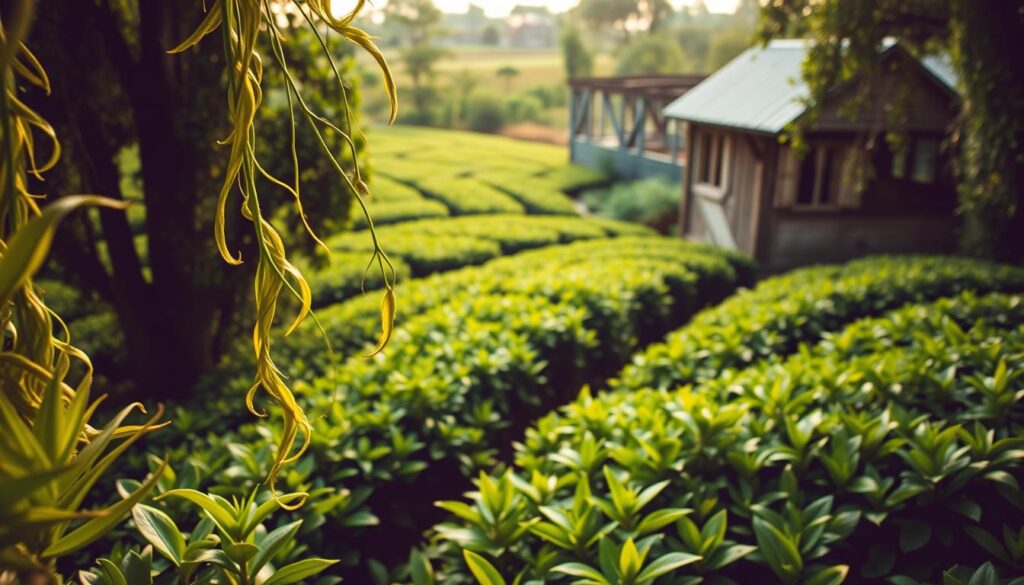
Exploring Wadmalaw Island and nearby Lowcountry landmarks
Your day starts with a tour at Charleston Tea Garden, then moves to the serene Wadmalaw Island. On the way, you’ll see marshes, Spanish moss, and a glimpse of life on a tea farm in South Carolina.
Visit the Angel Oak on Johns Island next. This towering live oak stands about 65 feet tall and spreads its branches wide. Its age is estimated between 300 to 500 years, with local stories saying it’s over 1,400 years old. Charleston City has been protecting Angel Oak Park since 1991, keeping this symbol of the Lowcountry safe.
Driving to Wadmalaw Island, you cross Church Creek over the island’s single bridge. You’ll see areas connected to Rockville, claimed for England in 1666 by Captain Robert Sanford. Before reaching the tea farm, a stop at Angel Oak Restaurant offers meals made with local ingredients.
Your journey around nature and history adds meaning to a Charleston Tea Garden tour. These places help you learn about the area, its weather, and the people who have lived here. Their efforts range from early settlements to today’s efforts to conserve nature.
| Lowcountry Highlight | Why It Matters | Essential Details | Pairing Tip |
|---|---|---|---|
| Angel Oak (Johns Island) | Showcases centuries of coastal ecology and community care | Height ~65 ft; canopy ~17,000 sq ft; longest limb ~187 ft; city stewardship since 1991 | Visit early for soft light, then continue to your Charleston Tea Garden tour |
| Church Creek Bridge to Wadmalaw Island | Gateway to fields, waterways, and historic byways | Only bridge onto the island; views of tidal marsh and moss-draped oaks | Pause for photos before exploring the tea farm South Carolina celebrates |
| Rockville Heritage Corridor | Links modern routes to 1666 claims by Captain Robert Sanford | Historic village setting with coastal breezes and shaded lanes | Drive slowly to take in scenery en route to Wadmalaw Island |
| Angel Oak Restaurant | Farm-to-table dining that reflects local producers | Seasonal menus sourced from nearby farms and waters | Plan lunch before or after the Charleston Tea Garden tour |
Tasting American Classic tea: what to sample during your visit
When you enter the visitor center, you’ll be greeted with a free American Classic tea. You can choose from hot or iced, sweet or plain. Staff are always brewing fresh tea. This experience connects you directly to the tea fields outside. You’ll get to taste a true U.S.-grown tea from plants raised right at the Charleston Tea Garden.
A must-try is the Charleston Breakfast-style black tea. Have it hot for a brisk, fresh taste or iced for a refreshing drink. For those visiting with children, try the mint iced black tea. It’s cool, bright, and gentle for everyone.
The time of year affects the flavor. From May to October, the harvest changes the tea’s taste. Early season, expect soft floral tastes. By summer, the flavors grow deeper. Touring the Charleston Tea Garden, you’ll learn how different seasons change the tea’s flavor.
After sampling teas, check out the gift shop. You can buy American Classic tea and related items to take home. The garden spans 127 acres and does everything on-site. This includes growing, processing, and brewing. This means what you learn on the tour matches what you taste in your tea.
- Hot pours: Charleston Breakfast-style black, unsweetened or lightly sweetened
- Iced pours: classic black, mint-infused options popular with families
- Seasonal notes: May–October lots with shifting aroma and body
- Take-home picks: tin or box formats of American Classic tea and gift sets
The Charleston Tea Garden stands out among American tea producers. Here, you get a unique “farm-to-cup” experience. You can taste the tea right where it’s grown. Then, see and understand every step that brings out its delicious flavor.
Conclusion
You came to see American grown tea and discovered living history on Wadmalaw Island. The Charleston Tea Garden tour shows you fields over 127 acres, a no-pesticide policy, and conservation efforts by the Bigelow family and tea expert William Barclay Hall. You learn how over 320 tea varieties grow well in the Lowcountry’s sun and salt air, and then see the “Green Giant,” a big harvester.
Make plans for both the self-guided factory tour and the narrated trolley ride. Arrive early, especially if you’re driving from Charleston, which takes about 40 minutes. The best time to see tea processing is from May to October, but the exhibits are always interesting. Bring a picnic, explore the tea fields, and stop by the Propagation Hut to see how new plants are started.
Consider visiting the Angel Oak or driving through Rockville to get the full local experience. Take home some American Classic tea. This way, you can remember your Charleston Tea Garden tour every time you have a cup. Each sip reminds you that American tea has strong roots on Wadmalaw Island. And that you were part of its ongoing story.

